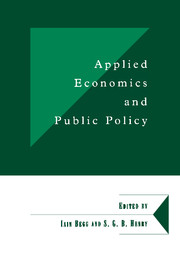Book contents
- Frontmatter
- Contents
- List of figures
- List of tables
- List of contributors
- Foreword
- 1 Introduction
- Part One MODELLING AND FORECASTING METHODS
- Part Two COMBINING DATA AND ANALYTIC TECHNIQUES
- 6 Takeovers, institutional investment and the persistence of profits
- 7 Semi-parametric estimation of the company size–growth relation
- 8 Wage-earnings in Great Britain during the Industrial Revolution
- 9 Company failure and hysteresis
- Part Three USING MODELS TO GUIDE POLICY
- Bibliography
- Index
9 - Company failure and hysteresis
from Part Two - COMBINING DATA AND ANALYTIC TECHNIQUES
Published online by Cambridge University Press: 06 July 2010
- Frontmatter
- Contents
- List of figures
- List of tables
- List of contributors
- Foreword
- 1 Introduction
- Part One MODELLING AND FORECASTING METHODS
- Part Two COMBINING DATA AND ANALYTIC TECHNIQUES
- 6 Takeovers, institutional investment and the persistence of profits
- 7 Semi-parametric estimation of the company size–growth relation
- 8 Wage-earnings in Great Britain during the Industrial Revolution
- 9 Company failure and hysteresis
- Part Three USING MODELS TO GUIDE POLICY
- Bibliography
- Index
Summary
Introduction
This chapter combines two strands which have run through the work of the DAE for most of its life. The first is the disaggregated modelling of the UK economy which originated in the research of Dick Stone's team in the early days of the DAE and flourishes still, under the direction of Terry Barker. The second is the construction and analysis of a large databank of UK company accounts which the second Director of the DAE, Brian Reddaway, helped to launch in the sixties with Geoffrey Whittington, and which has been completed just this year.
Here we combine this UK model with the company databank to analyse a piece of economic history located part way through the DAE's lifetime: the spate of failures of large listed UK companies in the 1979–83 recession. From the time of the DAE's birth until that recession, company failure was relatively rare among larger listed British companies – probably around the rate of one per thousand per year calculated by Mueller (1986) for their counterparts in the US. But then, suddenly, between 1979 and 1983, 30 of them failed.
The following sections explore the contribution to these failures of certain exogenous, policy-related macroeconomic shocks. Sections 9.2 and 9.3 outline the modelling framework: section 9.2 presents a macro–micro model which generates financial accounts for each company contingent on the setting of exogenous macroeconomic variables; section 9.3 presents a model of company failure in which pre-failure company accounts provide the explanatory variables.
- Type
- Chapter
- Information
- Applied Economics and Public Policy , pp. 209 - 222Publisher: Cambridge University PressPrint publication year: 1998
- 3
- Cited by



